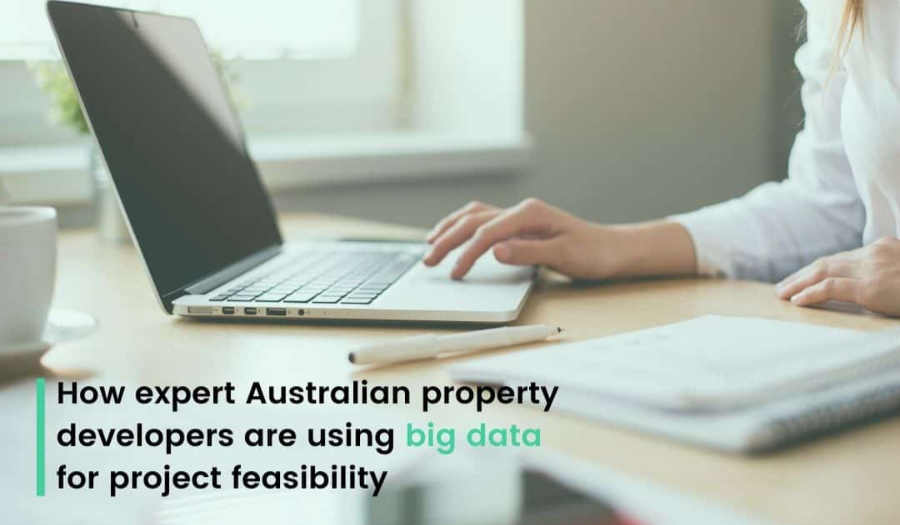
How expert Australian property developers are using big data for project feasibility
by Marshall Condon | April 12, 2020
Ensuring that a commercial development was profitable ten years ago was relatively straightforward. You’d consider macro factors such as the economic climate, geopolitical issues, applicable legislation, and regulation, plus what was happening with the Australian currency.
You’d then add to the mix what was happening with local, national, and even global market competition, then calculate how quickly you could get your development to market. Access to capital was another key profitability factor.
If these signals were positive, you’d then research and learn what type of property was most desirable for the area you had in mind, as well as what would appeal to your target market. One of the tried-and-tested ways of doing this was by talking to local real estate agents, who were able to provide information about in-demand properties and their attributes, as well as which demographic groups were buying in the area.
This would be followed by attending open homes, where developers could view property features first-hand, providing inspiration for future developments. Online research would also add some quantitative weight to the evaluation. This would give insights on asking versus sales prices, property ‘days to sell’ periods, and rental prices in the area.
Go-ahead if ‘stars align’
Finally, good old fashioned gut instinct and industry experience would be applied. If all of these factors aligned, a developer could be relatively confident their project’s bottom line would end up in the black and they’d go ahead and create a marketable product.
This was the process of determining profitability, which stood the commercial property development industry in good stead for many years. However, in these days of ‘big data’, this is not enough.
There are a plethora of information sources nowadays that help remove that final ‘gut instinct’ step from the equation and provide additional measurable science to the profitability question. These fall under the umbrella term of ‘big data’.
Explore big data sources
According to successful Australian property investor and developer, Michael Yardney, there are a number of property data sources that provide leading indicators – predictors of what’s going to happen in the future.
He personally consults the following property data sources to help determine the viability of a property investment:
The Finder real estate website adds that most government and council websites provide reports or community profiles that disclose information about council plans, development projects, or building regulations that help commercial property developers and investors understand the supply and demand of an area and offer data to further refine a search.
For example, a suburb analysis report from Residex lets you enter your suburb of interest, and a pdf report is available for download within minutes. This provides details such as the median value of properties and the number of properties and people within it. You can also dig deeper into the data to find out the demographics of the suburb, the nature of home ownership, and the property types.
Digital real estate media business, REA Group, has several websites that contain data that can help research the potential profitability of a commercial property development. These include the commercial property website realcommercial.com.au, risk management and market intelligence website hometrack, and the residential real estate portal realestate.com.au.
Core Logic (formerly RP Data), Real Estate Investar (REI), and PriceFinder also offer comprehensive property data, as well as detailed reports and other information and resources. Property Resource Shop offers some probing real estate market commentary. From this array of property data sources you can get sales history and ownership details, Comparative Market Analysis (CMA) reports, market valuations, and ‘on the market’ reports – pretty much any data on any property development or investment you have in mind.
Evaluate non-traditional data sources
Advances in technology are using the availability of this big data to take the property development decision-making process one step further. While most of the above sources use ‘traditional’ property information – such as occupancy rates and property prices – to help paint a picture of the viability of an investment, artificial intelligence, and machine learning are being used to crunch ‘non-traditional’, or ‘alternative’, data for deeper insights.
According to consulting firm McKinsey, developers have always sought to understand where to acquire property and when to trigger development. “Analysts must sift through tens of millions of records or data points to discern clear patterns and place their bets with few supporting tools. By the time an investor can collect, compile, and process the data needed to distill action, the best opportunities are gone,” they claim.
They explain that next-generation developers are using new and unconventional data sources like resident surveys, mobile phone signal patterns, and Yelp reviews of local restaurants to help identify ‘hyperlocal’ patterns and predict where to build or invest.
Other non-traditional data sources that helping to refine property insights are:
-
- Traffic information from GPS
- Developers’ own database
- Survey information from previous customers
- Focus groups
- Job ad listings
- Social media posts
- Police and crime websites, such as the Queensland Police Service
- Your local bank, lender, or mortgage broker
No data off-limits
No data should be considered off-limits to the modern commercial property developer. Even advertising statistics should be embraced and interrogated for their insights. For example, real estate websites can provide detailed information on who is browsing their listings and clicking on which adverts. This can give valuable demographic insights.
And the latest outdoor advertising even measures pedestrian and vehicular traffic, as well as demographic information from cellphone signals. This, in turn, can unlock gender, age, race, income, interests, and purchasing habits. All of this is valuable information that a property developer can use to help determine if their project is targeting the right market.
Multinational professional services firm, EY, says its research indicates that the property industry may be underestimating the impact of the disruptive forces starting to emerge. “The way property is constructed, transacted, valued and invested can all change, and all can affect profitability and returns,” they add.
The use of big data and the technology that’s interpreting it are disrupting the property sector for the better. However, it requires forward-thinking commercial property developers to move outside their comfort zone of tradition to harness the opportunities.
Stanford University researchers conclude the ability to draw insights from data provides unprecedented potential for enhancing real estate development decisions. This can be accomplished through better forecasts for building utilisation, more accurate assessment of the purchasing power and better risk assessment real estate users. This, in turn, helps ensure a more profitable commercial development.
What’s next?
If you have done your due diligence and are now looking for funding to expand your property development portfolio, check out our streamlined registration and application process. We’ll do an initial evaluation of your financing needs then connect you to lenders for non-bank property development finance at competitive terms and rates.
Click here to start your loan application: https://platform.wefund.com.au/register
RECEIVE UPDATES

Have a loan scenario?
Find out how wefund can help you with fast, transparent non-bank property and development finance. Provide your scenario details below and we’ll get back to you right away.
© 2025. All rights reserved.



